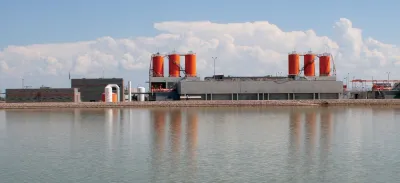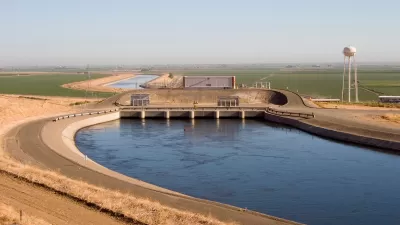As water supplies become strained and technology advances, cities look to wastewater as a viable source of drinking water.

A new water purification facility in El Paso, Texas will clean and deliver 10 million gallons of water per day from the city’s wastewater system to its drinking water system. “El Paso’s Pure Water Center, which will go online by 2028, is the first direct-to-distribution reuse facility in the country,” writes Martha Pskowski in Governing.
As Pskowski explains, “The advanced purification process begins with treated wastewater from the Roberto Bustamante Wastewater Treatment Plant in El Paso. This source water then goes through a multiple barrier system, first going through reverse osmosis, in which a membrane separates water molecules from other substances. Then hydrogen peroxide and ultraviolet light are used to kill bacteria in the water. Next, activated carbon absorbs chemicals or compounds in the water. Lastly, chlorine is added for disinfection.”
The project’s technology underwent testing before gaining approval from the Texas Commission on Environmental Quality (TCEQ). However, “Environmental advocates have raised concerns about contaminants of emerging concern in the purified water, like per- and polyfluoroalkyl substances (PFAS), which aren’t yet regulated in drinking water.”
This would be El Paso’s first direct-to-distribution system, but the city has been distributing treated wastewater for irrigation since the 1960s and pumping treated wastewater into local reservoirs since the 1980s. While El Paso is the first city to break ground on its project, Phoenix and Tucson are expected to start work on their own wastewater purification projects soon, and a similar project has been in the works in San Diego for years.
FULL STORY: El Paso Breaks Ground on First U.S. Facility to Turn Wastewater Into Drinking Water

Maui's Vacation Rental Debate Turns Ugly
Verbal attacks, misinformation campaigns and fistfights plague a high-stakes debate to convert thousands of vacation rentals into long-term housing.

Planetizen Federal Action Tracker
A weekly monitor of how Trump’s orders and actions are impacting planners and planning in America.

San Francisco Suspends Traffic Calming Amidst Record Deaths
Citing “a challenging fiscal landscape,” the city will cease the program on the heels of 42 traffic deaths, including 24 pedestrians.

Defunct Pittsburgh Power Plant to Become Residential Tower
A decommissioned steam heat plant will be redeveloped into almost 100 affordable housing units.

Trump Prompts Restructuring of Transportation Research Board in “Unprecedented Overreach”
The TRB has eliminated more than half of its committees including those focused on climate, equity, and cities.

Amtrak Rolls Out New Orleans to Alabama “Mardi Gras” Train
The new service will operate morning and evening departures between Mobile and New Orleans.
Urban Design for Planners 1: Software Tools
This six-course series explores essential urban design concepts using open source software and equips planners with the tools they need to participate fully in the urban design process.
Planning for Universal Design
Learn the tools for implementing Universal Design in planning regulations.
Heyer Gruel & Associates PA
JM Goldson LLC
Custer County Colorado
City of Camden Redevelopment Agency
City of Astoria
Transportation Research & Education Center (TREC) at Portland State University
Jefferson Parish Government
Camden Redevelopment Agency
City of Claremont





























